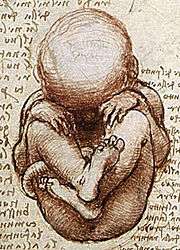Human development (biology)
| Part of a series on |
| Human growth and development |
|---|
 |
| Stages |
| Biological milestones |
| Development and psychology |
|
Human development is the process of growing to maturity. In biological terms, this entails growth from a one-celled zygote to an adult human being.
Biological development
General aspects

Fertilization occurs when the sperm successfully enters the ovum's membrane. The genetical material of the sperm and egg that combine to form a single cell, called a zygote, and the germinal stage of prenatal development commences.[1] The germinal stage refers to the time from fertilization, through the development of the early embryo, up until implantation. The germinal stage is over at about 10 days of gestation.[2]
The zygote contains a full complement of genetic material and develops into the embryo. Briefly, embryonic developments have four stages: the morula stage, the bastula stage, the gastrula stage, and the neurula stage. Prior to implantation, the embryo remains in a protein shell, the zona pellucida, and undergoes a series of cell divisions, called mitosis. A week after fertilization the embryo still has not grown in size, but hatches from the zona pellucida and adheres to the lining of the mother's uterus. This induces a decidual reaction, wherein the uterine cells proliferate and surround the embryo thus causing it to become embedded within the uterine tissue. The embryo, meanwhile, proliferates and develops both into embryonic and extra-embryonic tissue, the latter forming the fetal membranes and the placenta. In humans, the embryo is referred to as a fetus in the later stages of prenatal development. The transition from embryo to fetus is arbitrarily defined as occurring 8 weeks after fertilization. In comparison to the embryo, the fetus has more recognizable external features and a set of progressively developing internal organs. A nearly identical process occurs in other species.
Physical stages
The following are some approximate age ranges for physical development stages:

- Prenatal (sperm fertilizes egg - birth)
- Embryo (fertilization - 8 weeks after fertilization)
- Zygote, the single cell stage which occurs after fertilization
- Blastocyst, the stage prior to implantation, when the embryo is a hollow sphere
- Post-implantation embryo, the period 1 – 8 weeks after fertilization (3 to 10 weeks gestation)
- Fetus, (10th week of pregnancy - birth)
- Embryo (fertilization - 8 weeks after fertilization)



- Childhood/Juvenile (Childbirth) (0 - 19)
- Neonate (newborn) (0 – 28 days)
- Infant (baby) (0 month - 12 months)
- Toddler (1 – 3 years)
- Play age (3 – 5 years)
- Primary school age (middle childhood also called prepubescence) (6 - 11)
- Elementary school age (6 - 11)
- Preadolescence (The child in this and the previous phase are called schoolchild (schoolboy or schoolgirl), when still of primary school age.) (9 – 11 years)
- Adolescence (12 – 19 years)
- Adulthood (20+ years)
- Young adulthood (20 – 39 years)
- Middle adulthood (40 – 60 years)
- Elder/Senior citizen (60+ years)
- Death (unpredictable)
- Decomposition (breakdown of the body after death)
Also sometimes used are terms that specify one's age in numbers, such as:
- Baby (0)
- Toddler (1 - 2)
- Preschooler (3 - 4)
- Main childhood (5 - 9)
- Pre-teenager (10-12)
- Teenager (13-19)
- Twentysomething (20-29)
- Thirtysomething (30-39)
- Fortysomething (40-49)
- Fiftysomething (50-59)
- Sixtysomething (60-69)
- Seventysomething (70-79)
- Eightysomething (80-89)
- Ninetysomething (90-99)
- Centenarian (100-109)
- Supercentenarian (110+)
The Tanner stages can be used to approximately judge a child's age based on physical development.
See also
Footnotes
- ↑ Sherk, Stephanie Dionne. "http://www.healthline.com/galecontent/prenatal-development". Gale Encyclopedia of Children's Health, 2006. Gale. Retrieved 6 October 2013. External link in
|title=(help) - ↑ "germinal stage". Mosby's Medical Dictionary, 8th edition. Elsevier. Retrieved 6 October 2013.
- ↑ Growth of Asthmatic Children Before Long-Term Treatment with Inhaled Corticosteroids T. Moudiou, D. Theophilatou, K. Priftis and A. Papadimitriou, M.D. Journal of Asthma. 2003, Vol. 40, No. 6, Pages 667-671.
- 1 2 Jaffe-Campanacci Syndrome. A Case Report and Review of the Literature. Mohammad Anwar Hau, MBBS, MMed (Ortho), Edward J. Fox, MD, Justin M. Cates, MD, PhD, Brian E. Brigman, MD and Henry J. Mankin, MD. The Journal of Bone and Joint Surgery (American) 84:634-638 (2002)
- ↑ Persistent osteopenia in adolescent idiopathic scoliosis (AIS) – Factors predisposing to generalized osteopenia, a cross-sectional and longitudinal investigation Warren T.K. Leea, C.S.K. Cheunga, Y.K. Tsec, W.W. Chaua, L. Qina and Jack C.Y. Chenga. doi:10.1016/j.ics.2006.08.003